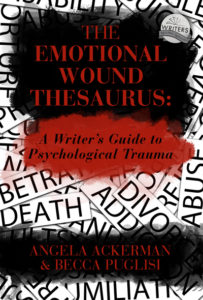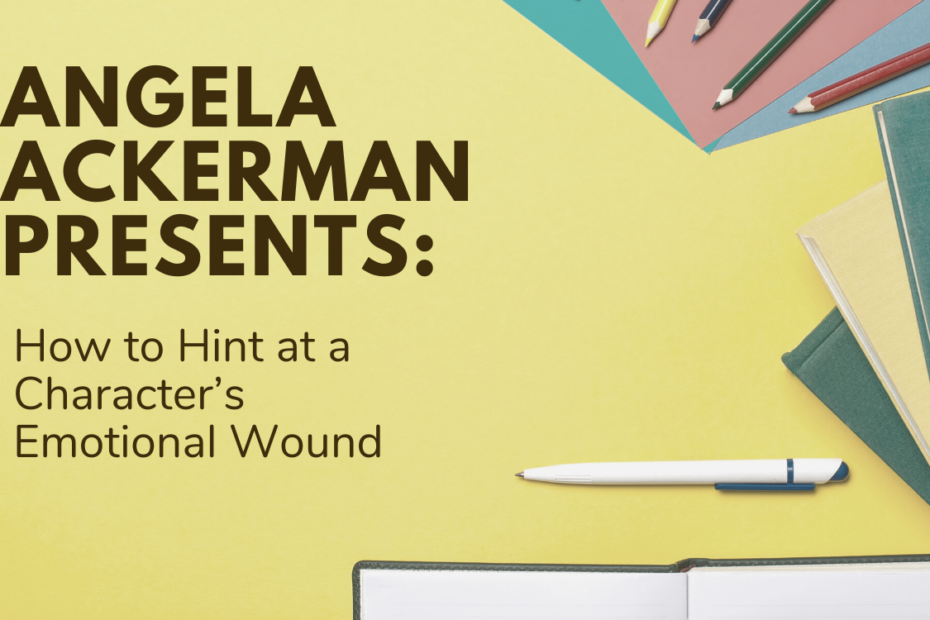Another fabulous post by Angela Ackerman – every romance writer needs to know about emotional wounds for their characters! You’re going to want to bookmark this post!

Regardless of whether you choose to show the emotional wound overtly during the story or merely hint at it, it will always be necessary to reference the event in smaller ways throughout. It’s a piece of the character’s past that holds vital significance; someone who’s endured the loss of a loved one, physical torture, or a messy divorce can’t simply forget it—especially if it hasn’t been dealt with. It will haunt her, and continue to hold her back in the story until it is dealt with.
Mastering the art of obliquely referencing what has happened in a way that reads naturally is an important skill to master as it pulls the reader deeper into the story through the art of subtext. There are many ways to seed ideas in the reader’s mind about the type of emotional trauma a character has suffered, including showing it through defense mechanisms. Here are three additional ways you can feed information about the event to readers without using info dumps or giving the whole thing away.
Use the Character’s Greatest Fear

For instance, let’s say your character experienced a failure, one that resulted in major fallout for a lot of people. As a result, this character —we’ll call her Jess—may avoid being in charge because she doesn’t want to risk repeating that experience. You can hint at this by creating situations that show her shunning responsibility. At work, she might be offered a chance to lead an all-star team in a bid to bag a wealthy client. To the reader, the decision seems like a no-brainer. But Jess cites lame reasons and declines, or she accepts, then fabricates an excuse to back out. This avoidance raises questions. Why would she pass up such an amazing opportunity? What is she afraid of? And why has she chosen a career that affords opportunities like these if she’s going to sidestep them when they come along?
Avoidance is great for referencing, in a roundabout way, a character’s fear; when this by-product is combined with other clues, readers can figure out what’s haunting her. It’s also good for the character arc. In the case of our irresponsible lead, she is allowing her fear to keep her from true happiness, and she won’t be whole until she faces and overcomes it.
In a well-structured story, this won’t happen immediately. She’ll need many chances to triumph (and fail) before she realizes that her fear is holding her back. Building these scenarios into the plotline will provide the chances she needs to move along that character arc toward eventual success.
Showcase the Character’s Self-Doubt

Look at Jess. She might be confident and self-assured most of the time but feels insecure in certain situations: when she has to lead, when people are depending on her, or when an important decision needs to be made. Her self-doubt may also be tied to specific circumstances surrounding her past failure. For instance, if she goofed up in a TV interview, she may become a nervous wreck in a public forum or anytime she has to go on the record.
Once you’ve decided on your character’s wounding incident, ask yourself some questions to better understand her insecurities relating to it. When does she doubt herself? In what scenario does she not trust her intuition? When does a simple decision paralyze or turn her into a second-guessing mess? The answers to these questions will let you know where her uncertainties lie; you can then show the contrast between her normal self and the circumstances where her personality changes. Done consistently, this can shine a spotlight on your character’s doubts, hinting at her wounding event and showing how it’s impacting her even now.
Let Overreactions and Underreactions Do the Talking
When you know your character well, you’re able to write her consistently. Readers get to know her and what to expect from her in the various situations that arise. If she reacts in a way that’s either understated or overly dramatic, it’s like a red flag for readers, telling them that something isn’t quite right.
Let’s imagine that Jess is typically an outgoing, bigger-than-life kind of girl. She’s always up for a party, so when her company throws a celebratory bash, she’s there in all her extroverted glory—until she’s asked to field questions from the local news crew. We’d expect a person like Jess to respond with exuberance at the chance to ham it up for the cameras. Instead, the animation leaves her face. Her body goes still, and the pitch of her voice drops. With a stricken smile, she declines, suggests someone else as a replacement, and excuses herself.
This response is way too subdued for the Jess we’ve come to know. It’s a sign that something about this interview scenario is freaking her out. We’d be similarly alerted in a situation in which a run-of-the-mill response was expected but she went ballistic.
If you’ve laid the foundation for your character’s personality and have remained true to her emotional range throughout the story, contrary reactions will warn readers that something is wrong while allowing you to hint at trouble from the past.
For more ideas on how to dole out information about your character’s past and show the aftereffects through behavior shifts, take a peek at The Emotional Wound Thesaurus: A Writer’s Guide to Psychological Trauma.
Have you used these three elements to seed information about your character’s wounded past? Let me know in the comments!
